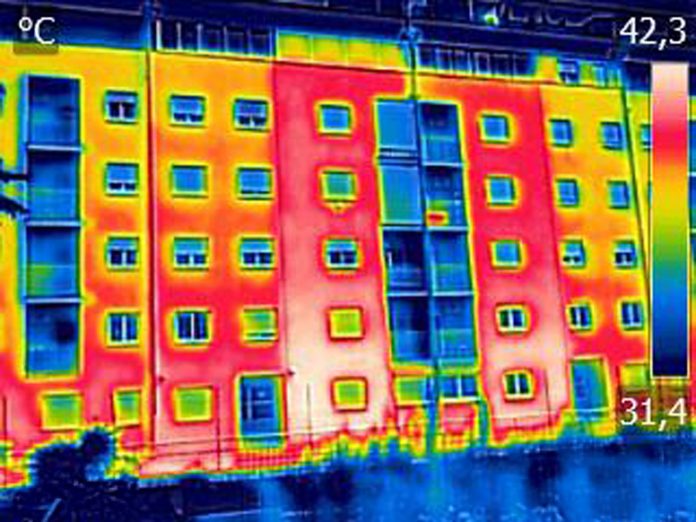The British obsession with the weather stems from the fact we are used to living in a temperate zone with clearly defined seasons: not terribly cold in winter, not that hot in summer and definitely varied…but all that has changed, with serious implications for our buildings, according to David Frise, chief executive officer of the Building Engineering Services Association
The intense thunderstorms the UK has been experiencing this summer are just the latest symptoms of our changing climate. Mild, wet winters are now regular features and spring is all over the place. You might argue we didn’t actually have one this year as April was unseasonably cold and dry while May was just wet.
Of course, this is nothing compared with what has been going on in Canada and many parts of the US recently. Death Valley recorded 54C, which is pretty much beyond human endurance.
Our weather has changed, and we probably didn’t need a new report from the independent advisory body the Committee for Climate Change (CCC) to confirm what we already knew: our climate is warming up fast and becoming more volatile.
Unfortunately, the government seems to be having trouble getting its head around this fact and still seems to think we live in a cold country. It was warned by the CCC five years ago that overheating in buildings was one of the most urgent climate change issues, but since then another 570,000 new homes have been built without any climate adaption measures. A further 1.5m are due to be built in the next five years.
Locked in
The CCC says there is now a high likelihood that our buildings will have overheating problems “locked in” unless we totally rethink our approach.
“Inaction now will create unnecessary retrofit costs later and could even leave many existing and new homes uninhabitable as temperatures rise,” the CCC report said.
If we remain on our current path, we are looking at another 29 years of building tight towards 2050 net zero goals – that’s 8.7m new homes if the government achieves its aim of building 300,000 a year. They might all be uninhabitable by 2050.
The committee also points out that there were 2,500 heat-related deaths during the 2020 heatwave in England, which was higher than at any time since records began and, without mitigation measures, heat-related deaths would treble by 2050. The increase in the number of people now working from home would only make the problem worse, the committee said.
Baroness Brown, chair of the CCC’s adaptation committee, said policies aimed at achieving net zero did not address this problem because the climate was already changing and would go on changing up to and beyond 2050.
“By better understanding and preparing for the coming changes, the UK can prosper, protecting its people, its economy and its natural environment. A detailed, effective action plan that prepares the UK for climate change is now essential and needed urgently,” she said.
Energy efficiency measures have been the priority for both residential and commercial buildings for many years, which means higher levels of insulation and air tightness. But if you build tight, you have to ventilate right, as the saying goes. This has clearly not been the case and occupants are suffering.
Airtight design also increases the risk of creating a heavily contaminated indoor environment, which is why indoor air quality (IAQ) is often many times worse than the air outside the building.
This should also prompt us to redefine what we mean by sustainability. Currently, many people consider energy efficiency to be the main ingredient for a climate resilient built environment but in fact, it can undermine sustainability by creating indoor environments that are uncomfortable, unhealthy and definitely not sustainable for human beings in the long-term.
Government policy continues to focus on “heat” with new headline-grabbing plans to ban gas boilers by 2025 and a push to install 600,000 heat pumps a year by 2030. All of which reinforces the illusion that we still live in a cold country.
The term “wellbeing” is used repeatedly in design discussions but the features that underpin human health are often value engineered out before a building is completed. This is particularly true of new homes, many of which have little in the way of ventilation beyond opening windows. So-called natural ventilation in urban settings can deliver the double negative of outdoor pollution coming in and little in the way of air movement to dilute indoor sources of contamination – and disease.
The current revision of the Building Regulations is an opportunity for the government to follow CCC advice and closely marry the revised Part L with Part F of the regulations and flip the argument so that we start from a new place: “How are we going to keep this building cool?”
Asthma attacks
Healthcare professionals regularly point out that, whenever we have rising temperatures in this country, we have a spike in asthma attacks. BESA’s Buildings as Safe Havens (BASH) campaign promotes the concept of buildings being designed to protect occupants from the worst aspects of rising outdoor pollution and controlling/ reducing sources of indoor pollutants.
This work has taken on new urgency in light of the lessons learned during the pandemic about the way poorly ventilated spaces increase the risk of disease transmission. Public Health England had labelled the increase in respiratory infections in children linked to poor IAQ as a “national health emergency” long before Covid came along.
This is also a building safety issue but overheating and IAQ are not mentioned in the draft Building Safety Bill. How can an overheating building be safe if it is the root cause of poor health and even death?
The proposed Environment Bill does, for the first time, talk about the challenge of INDOOR air quality as opposed to solely focusing on outdoor pollution, but its provisions are vague. We believe local authorities should be given the power to enforce mandatory measuring and monitoring of IAQ with specific focus on airborne particulates PM2.5 and below; along with CO2 levels; ozone and VOCs, which are linked to heart and lung diseases, as well as certain cancers.
NOx emissions from transport are another huge risk to health because they are known to cause inflammation of the airways, reduce lung function and increase the frequency and severity of asthma attacks.
We can deliver healthy indoor spaces without driving up energy costs by including the latest energy efficient ventilation systems, clean air technology and the air filtration standard (ISO16890) in the revised regulations.
The British Standards Institute (BSI) is also fast-tracking new IAQ measures into its forthcoming British Standard (BS 40101 Building Performance Evaluation) due to be published in November. This needs to follow the latest World Health Organisation (WHO) guidance, which is due to be published in September, and embed ambitious targets for measuring, monitoring and mitigating indoor pollution.
This is not a self-interested call for greater amounts of expensive ventilation technology to be installed in buildings up and down the country – although that does have an increasingly important place. However, there are many low-cost solutions to overheating and poor IAQ, including passive cooling techniques like solar shading, green planting and sun reflecting paint.
Building facades should be designed with overheating in mind and the orientation of the structure needs to be considered as this has a huge bearing on overheating. Everyone used to want a south-facing garden – now they might be better off looking north.
This can also be linked to the government’s “levelling up” agenda as the damage inflicted by climate change is already having a disproportionate impact on the most socially disadvantaged, who live in the poorest quality homes and in cramped urban conditions.
What is clear is that climate change is already reshaping our environment – this is not about far off targets. Cutting overheating through better design will move us towards our net zero goals in any case while improving people’s lives and making our building stock more sustainable…now.
We are still waiting for the publication of the government’s Heat and Buildings strategy, which was the subject of a parliamentary debate last December and has been delayed again until this autumn – a full two years after it was first promised. This is now vital to shape future thinking on this increasingly urgent topic.
To legislate for overheating calls for political courage because it requires immediate action. It is clearly much easier to set an emissions target far into the future when you will not be around to be held accountable. But deaths from overheating are happening now and the situation will only get worse.
We can stay on track for net zero and still tackle overheating if we “ventilate right when building tight”.
David Frise
Chief executive officer
Building Engineering Services Association
Tel: +44 (0)345 646 1044
Twitter: @BESAGroup
LinkedIn: BESA Group














